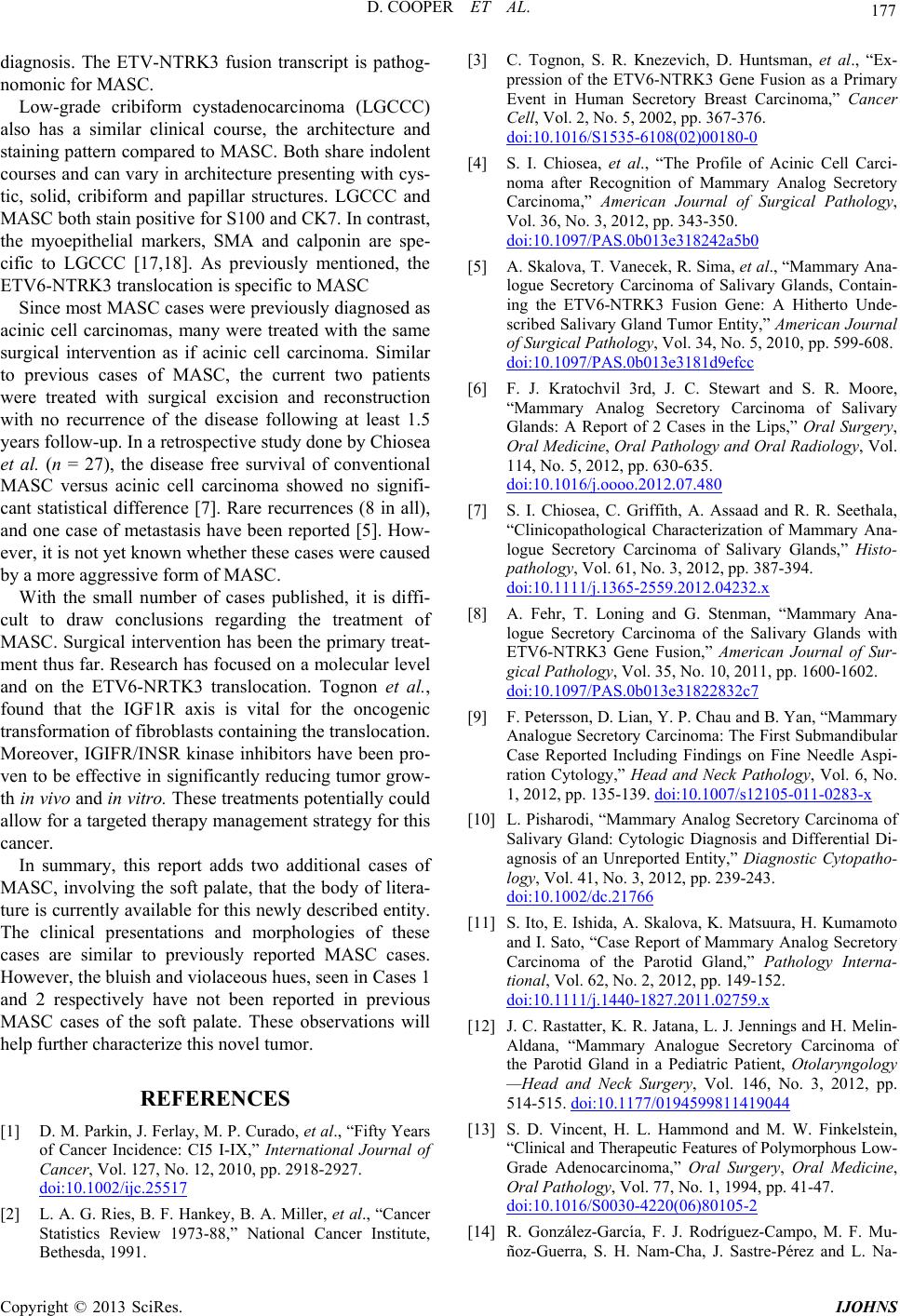
D. COOPER ET AL. 177
diagnosis. The ETV-NTRK3 fusion transcript is pathog-
nomonic for MASC.
Low-grade cribiform cystadenocarcinoma (LGCCC)
also has a similar clinical course, the architecture and
staining pattern compared to MASC. Both share indolent
courses and can vary in architecture presenting with cys-
tic, solid, cribiform and papillar structures. LGCCC and
MASC both stain positive for S10 0 and CK7. In contrast,
the myoepithelial markers, SMA and calponin are spe-
cific to LGCCC [17,18]. As previously mentioned, the
ETV6-NTRK3 translocation is specific to MASC
Since most MASC cases were previously diagnosed as
acinic cell carcinomas, many were treated with the same
surgical intervention as if acinic cell carcinoma. Similar
to previous cases of MASC, the current two patients
were treated with surgical excision and reconstruction
with no recurrence of the disease following at least 1.5
years follow-up. In a retrospective study done by Chio sea
et al. (n = 27), the disease free survival of conventional
MASC versus acinic cell carcinoma showed no signifi-
cant statistical difference [7]. Rare recurrences (8 in all),
and one case of metastasis have been reported [5]. How-
ever, it is not yet known whether these cases were caused
by a more aggressive form of MASC.
With the small number of cases published, it is diffi-
cult to draw conclusions regarding the treatment of
MASC. Surgical intervention has been the primary treat-
ment thus far. Research has focused on a molecular level
and on the ETV6-NRTK3 translocation. Tognon et al.,
found that the IGF1R axis is vital for the oncogenic
transformation of fibroblasts containing the translocation.
Moreover, IGIFR/INSR kinase inhibitors have been pro-
ven to be effective in significantly reducing tumor grow-
th in vivo and in vitro. These treatments p otentially cou ld
allow for a targeted therap y management strategy fo r this
cancer.
In summary, this report adds two additional cases of
MASC, involving the soft palate, that the body of litera-
ture is currently available for this n ewly described entity.
The clinical presentations and morphologies of these
cases are similar to previously reported MASC cases.
However, the bluish and violaceous hues, seen in Cases 1
and 2 respectively have not been reported in previous
MASC cases of the soft palate. These observations will
help further characterize this novel tumor.
REFERENCES
[1] D. M. Parkin, J. Ferlay, M. P. Curado, et al., “Fifty Year s
of Cancer Incidence: CI5 I-IX,” International Journal of
Cancer, Vol. 127, No. 12, 2010, pp. 2918-2927.
doi:10.1002/ijc.25517
[2] L. A. G. Ries, B. F. Hankey, B. A. Miller, et al., “Cancer
Statistics Review 1973-88,” National Cancer Institute,
Bethesda, 1991.
[3] C. Tognon, S. R. Knezevich, D. Huntsman, et al., “Ex-
pression of the ETV6-NTRK3 Gene Fusion as a Primary
Event in Human Secretory Breast Carcinoma,” Cancer
Cell, Vol. 2, No. 5, 2002, pp. 367-376.
doi:10.1016/S1535-6108(02)00180-0
[4] S. I. Chiosea, et al., “The Profile of Acinic Cell Carci-
noma after Recognition of Mammary Analog Secretory
Carcinoma,” American Journal of Surgical Pathology,
Vol. 36, No. 3, 2012, pp. 343-350.
doi:10.1097/PAS.0b013e318242a5b0
[5] A. Skalova, T. Vanecek, R. Sima, et al., “Mammary Ana -
logue Secretory Carcinoma of Salivary Glands, Contain-
ing the ETV6-NTRK3 Fusion Gene: A Hitherto Unde-
scribed Salivary Gland Tumor Entity,” American Journal
of Surgical Pathology, Vol. 34, No. 5, 2010, pp. 599-608.
doi:10.1097/PAS.0b013e3181d9efcc
[6] F. J. Kratochvil 3rd, J. C. Stewart and S. R. Moore,
“Mammary Analog Secretory Carcinoma of Salivary
Glands: A Report of 2 Cases in the Lips,” Oral Surgery,
Oral Medicine, Oral Pathology and Oral Radiology, Vol.
114, No. 5, 2012, pp. 630-635.
doi:10.1016/j.oooo.2012.07.480
[7] S. I. Chiosea, C. Griffith, A. Assaad and R. R. Seethala,
“Clinicopathological Characterization of Mammary Ana-
logue Secretory Carcinoma of Salivary Glands,” Histo-
pathology, Vol. 61, No. 3, 2012, pp. 387-394.
doi:10.1111/j.1365-2559.2012.04232.x
[8] A. Fehr, T. Loning and G. Stenman, “Mammary Ana-
logue Secretory Carcinoma of the Salivary Glands with
ETV6-NTRK3 Gene Fusion,” American Journal of Sur-
gical Pathology, Vol. 35, No. 10, 2011, pp. 1600-1602.
doi:10.1097/PAS.0b013e31822832c7
[9] F. Petersson, D. Lian, Y. P. Chau and B. Yan, “Mammary
Analogue Secretory Carcinoma: The First Submandibular
Case Reported Including Findings on Fine Needle Aspi-
ration Cytology,” Head and Neck Pathology, Vol. 6, No.
1, 2012, pp. 135-139. doi:10.1007/s12105-011-0283-x
[10] L. Pisharodi, “Mammary Analog Secretory Carcinoma of
Salivary Gland: Cytologic Diagnosis and Differential Di-
agnosis of an Unreported Entity,” Diagnostic Cytopatho-
logy, Vol. 41, No. 3, 2012, pp. 239-243.
doi:10.1002/dc.21766
[11] S. Ito, E. Ishida, A. Skalova, K. Matsuura, H. Kumamoto
and I. Sato, “Case Report of Mammary Analog Secretory
Carcinoma of the Parotid Gland,” Pathology Interna-
tional, Vol. 62, No. 2, 2012, pp. 149-152.
doi:10.1111/j.1440-1827.2011.02759.x
[12] J. C. Rastatter, K. R. Jatana , L. J. Jennings and H. Melin-
Aldana, “Mammary Analogue Secretory Carcinoma of
the Parotid Gland in a Pediatric Patient, Otolaryngology
—Head and Neck Surgery, Vol. 146, No. 3, 2012, pp.
514-515. doi:10.1177/0194599811419044
[13] S. D. Vincent, H. L. Hammond and M. W. Finkelstein,
“Clinical and Therapeutic Features of Poly morphous Low-
Grade Adenocarcinoma,” Oral Surgery, Oral Medicine,
Oral Pathology, Vol. 77, No. 1, 1994, pp. 41-47.
doi:10.1016/S0030-4220(06)80105-2
[14] R. González-García, F. J. Rodríguez-Campo, M. F. Mu-
ñoz-Guerra, S. H. Nam-Cha, J. Sastre-Pérez and L. Na-
Copyright © 2013 SciRes. IJOHNS